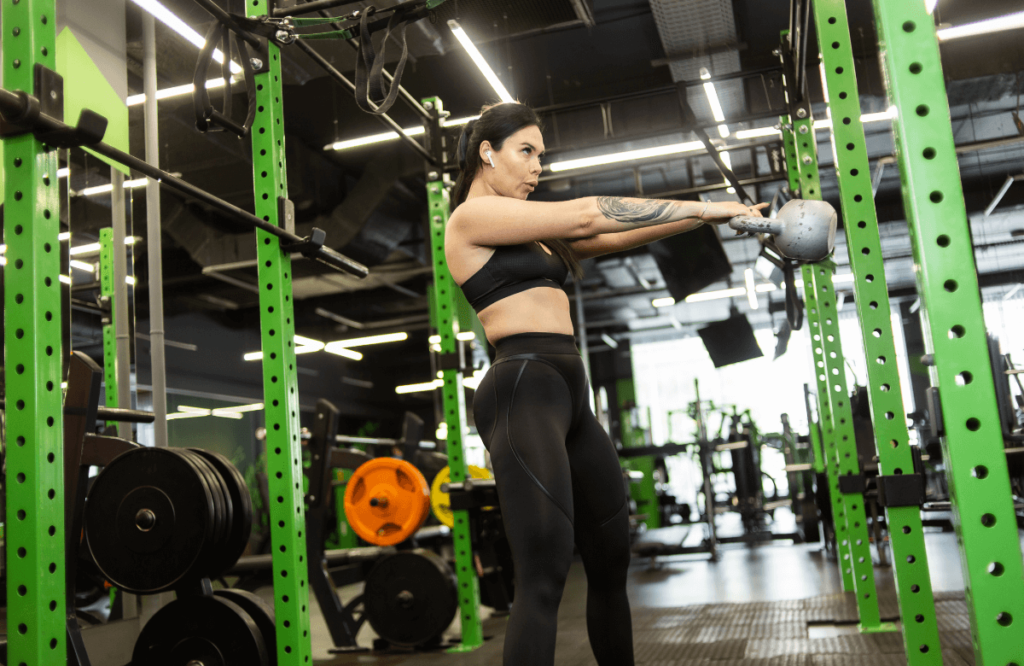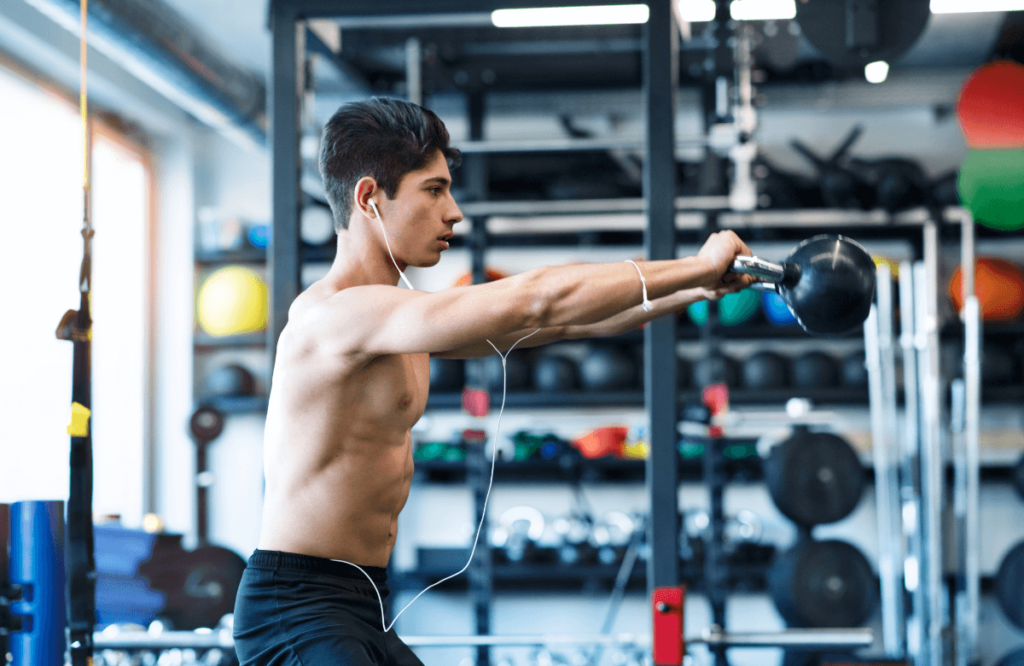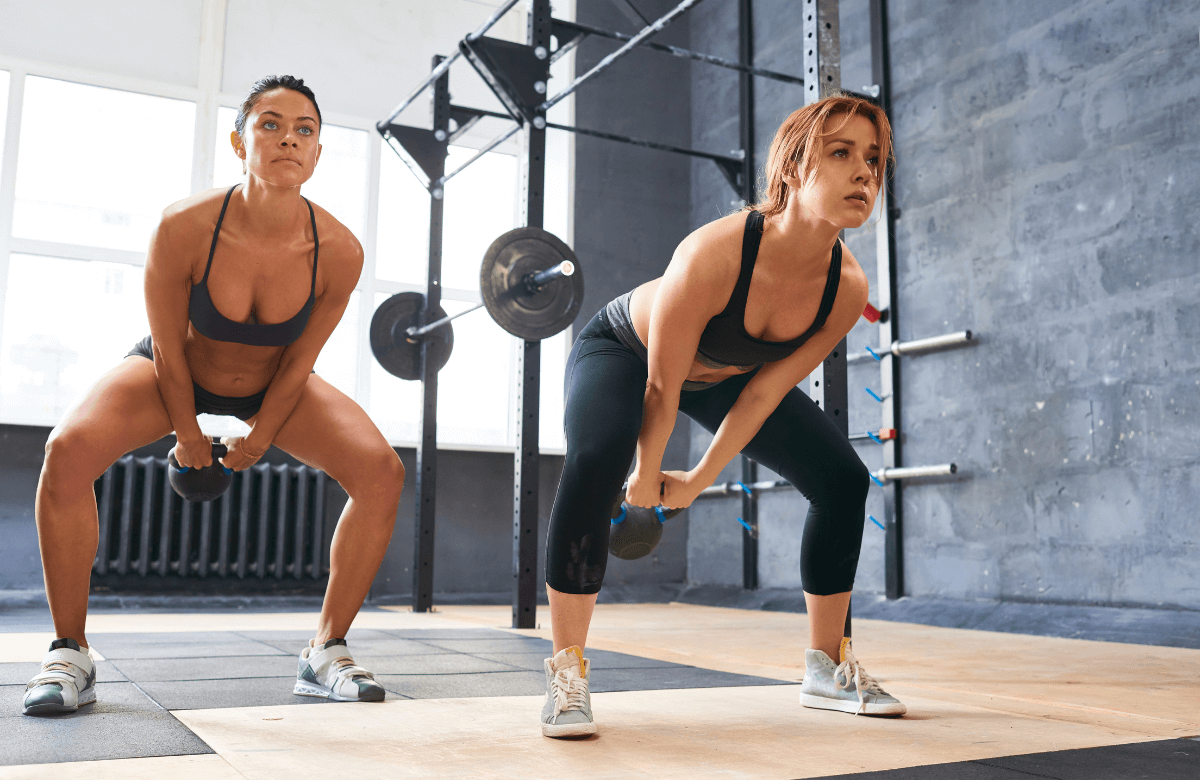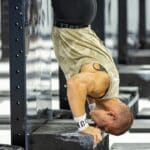The hamstrings are one of the most important muscles in our body. So, why not invest time and effort in keepiwng them as healthy and strong as possible? This article will teach how to bulletproof your hamstrings with 7 kettlebell hamstring exercises.
It doesn’t matter if you’re a beginner or an Olympic athlete; your hamstring muscles will thank you after training. Buckle up!

Jump to:
- Are Kettlebells Good For Hamstrings?
- Hamstrings Anatomy
- Benefits Of Strong Hamstrings
- 7 Kettlebell Exercises For Bulletproof Hamstrings
- 1) Kettlebell Swings
- 2) Kettlebell Deadlift
- 3) Kettlebell Good-Morning
- 4) Single-Leg Kettlebell Romanian Deadlift
- 5) Long-Lever Kettlebell Hip Thrust
- 6) Kettlebell Reverse Lunges
- 7) Kettlebell Nordic Hamstring Curl
- Do Kettlebells Work Hamstrings?
- Should My Hamstrings Be Sore After Kettlebell Swings?
- Is It OK To Do Kettlebell Swings Every day?
Are Kettlebells Good For Hamstrings?
Kettlebells are great for the hamstrings. They are versatile tools with an intuitive design that allows various effective exercises.
Although this is not a comparison, kettlebells are arguably better at targeting your hamstrings than dumbbells. They enable more fluid movements and can hit different movement patterns.
With kettlebells, you can go heavy for swings, deadlifts, and lunges. Or you can stay lighter for functional movements that require more mobility, like the kettlebell windmill exercise.
With several options to explore, it is evident that these are great tools to incorporate into your training sessions and build strong and muscular hamstrings.
Hamstrings Anatomy
The hamstrings are made of three muscles:
– Semitendinosus
– Semimembranosus
– Biceps Femoris.
These muscles cross two joints (hip and knee) which is why they’re responsible for knee flexion and hip extension.
They originate at the ischial tuberosity and insert at the medial and lateral condyle of the tibia.
The hamstrings muscles play a crucial role in deceleration. That’s one of the reasons why they’re the most injured muscle group in sports.
Hamstrings usually work closely with other muscle groups, such as the glutes, quadriceps, calves, and hip flexors. Together they bring stability to the knee, hip, and low back.

Benefits Of Strong Hamstrings
Having healthy and strong hamstrings go beyond aesthetics. Although that is important for many, the hamstrings are essential muscles that function as dynamic knee stabilizers and improve sports performance.
Take a look at these three fantastic benefits that come from strong hamstrings.
Healthier Knees and Hip
The hamstrings attach to the hip, aiding hip extension and the knees to allow knee flexion.
This dynamic is very important for both hip and knee health because there must be a balance between the flexors and extensors muscles.
If your quadriceps (knee extensors) are disproportionately stronger than your hamstrings, this can lead to knee instability, pain, or a potential injury.
Goes the same with the hip. Weak or overactive hamstrings can pull the hip into an anterior tilt that could lead to lumbar hyperextension and recurrent lumbalgia.
You’ll notice an improvement in knee stability when you strengthen your hamstrings along your core and buttock muscles.
Increased Speed and Explosiveness
Our ability to walk, jog, run and jump is enabled by the hamstrings (quads and glutes.) Every time we step forward, we create the mechanical condition for that front leg to pull us forward.
Without proper knee flexion, we lose the power to drive us forward with the aggression we sometimes need.
It’s no wonder hamstrings strains are the most common injuries in speed-related sports such as track and field and football soccer.
Developing strong hamstrings will minimize future injuries and improve your ability to generate speed and explosiveness safely.
Great for Aesthetics
Having muscle imbalances is unhealthy and can also look horrible with clothes on.
Building muscular and strong hamstrings can help you wear your favorite pair of jeans or skirts with supreme confidence.
The hamstrings will give your lower body a rounded and more filling appearance, including your buttock muscles.

7 Kettlebell Exercises For Bulletproof Hamstrings
Now that you know the importance of having strong and healthy hamstrings, we present you these seven kettlebell hamstring exercises that will get you to the top.
Most of these movements are easy to do. However, performing them with a proper technique and moderate-heavy weights is important.
Kettlebells are dynamic and intuitive, so most people shouldn’t have a problem pushing these muscles to the limit.
1) Kettlebell Swings
The kettlebell swing exercise is one of the most popular yet effective movements you can do with a kettlebell.
There are two variations: Russian Kettlebell Swing (KB stays at chest height) and American Kettlebell Swing (KB goes overhead).
Both involve the combination of hip flexion and aggressive hip extension. The American Swing variation also involves shoulder flexion by taking the weight overhead.
Because of the movement pattern, this exercise will recruit the hamstrings, glutes, spinal erectors, shoulders, and trapezius in the case of the American version.
Some people can experience soreness after their first attempts at the movement; regardless of that, it is a terrific hamstring kettlebell exercise.
2) Kettlebell Deadlift
Kettlebell deadlifts are among people’s favorite leg exercises. This is a challenging exercise to work the posterior chain muscles.
The deadlift will target the hamstrings and glute muscles in their lengthened position. While also working the spinal erectors, lats, and trapezius in their shortened position.
For the starting position, take a slight bend on the knees, and place the feet hip-width while keeping a neutral neck. Brace your core muscles, and send the hips back.
You can try several variations like the Romanian, Sumo, Banded, and Deficit kettlebell deadlift to push for more muscle growth.
3) Kettlebell Good-Morning
The good-morning exercise requires a slow and controlled hip hinge, followed by an equally controlled hip extension. All this while keeping a neutral spine and neck.
This movement can increase your hamstring’s range of motion because the entire exercise is about lengthening the muscle and spending time in the hinge.
Most people feel their hamstrings, glutes, and spinal erectors getting the most muscle activation.
You can try a close or sumo stance, one or two kettlebells, and even band-resisted ones. All these variations will also work your core muscles.
4) Single-Leg Kettlebell Romanian Deadlift
The single-leg Romanian deadlift is a fantastic exercise for developing the hamstring muscles and improving balance and proprioception.
Although this is often considered an advanced exercise, many can do it with the help of a stick, PVC pipe, or by being close to a wall.
Besides working on the hamstrings and glutes in their lengthened position, it also focuses on the feet muscles. Placing the feet flat on the floor (no shoes) can help to recruit more of the foot musculature.
Some variations include band-resisted, deficit, and cable-resisted. Each is a terrific choice to tone the hamstring muscles.
5) Long-Lever Kettlebell Hip Thrust
The long-lever kettlebell hip thrust is a beginner-intermediate exercise for increasing the hamstring’s ability to support your body weight.
This movement is famous for causing “cramps” on first attempts. However, they can also take on heavy loads when you use a barbell instead of a kettlebell.
For a proper form, place your upper back against a bench (make sure it won’t move). Start with your hips touching the floor and place your feet in front with around 120 degrees of knee flexion.
From there, extend your hips aggressively and contract your glutes at the top. You can use one or two legs and one or two kettlebells.
6) Kettlebell Reverse Lunges
Kettlebell reverse lunges should be a part of everyone’s strength training. It’s easy to do, challenging, and will take your hamstrings and glute muscles to the moon.
The reverse lunge exercise is one of the most popular among fitness enthusiasts. It’s a terrific movement to improve impaired muscle strength.
The groups with the most muscle activation are the quadriceps, hamstrings, and glutes. The trapezius and forearms are also in the mix.
Technique-wise, aim for an upright position and a neutral spine position. Although this can be an exercise for beginners, intermediate and advanced athletes always incorporate this movement in their routines.
7) Kettlebell Nordic Hamstring Curl
This is the perfect hamstring exercise. One of the greatest movements for reducing hamstring-related injury incidents.
The nordic hamstring curl focuses on the movement’s eccentric portion (the descent). It works the hamstrings at their lengthened position with a dynamic touch.
For the starting position, sit on your knees over a mat, place the kettlebells between your feet and press them against it. Before descending, brace your core muscles and contract your glutes throughout the exercise.
Feel free to use your hands to catch your fall and push you up to the starting position.
Do Kettlebells Work Hamstrings?
Yes, they do, and intensely! Kettlebells enable fluid movements and hit different movement patterns that recruit more muscle fibers through one session.
Should My Hamstrings Be Sore After Kettlebell Swings?
Not necessarily! Soreness is not an objective sign of muscle recruitment. It’s more common when you’re a beginner or inexperienced.
As you progress, you’ll notice the soreness less and less, and it doesn’t mean you’re not doing the work!
Is It OK To Do Kettlebell Swings Every day?
It’s okay if you fully recover before the next session. Ideally, you’d want a rest day in between, but if you need to do swings every day, we could suggest using light-moderate weights to minimize the risk of injury.














